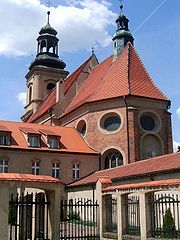Wschowa
Wschowa | |||
|---|---|---|---|
 View from Protestant church to town hall | |||
| |||
 Wschowa | |||
| Coordinates: 51°48′N 16°18′E / 51.800°N 16.300°E / 51.800; 16.300 | |||
| Country | |||
| Voivodeship | Lubusz | ||
| County | Wschowa County | ||
| Gmina | Gmina Wschowa | ||
| Government | |||
| • Mayor | Konrad Antkowiak | ||
| Area | |||
| • Total | 8.38 km2 (3.24 sq mi) | ||
| Population (2006) | |||
| • Total | 14,573 | ||
| • Density | 1,700/km2 (4,500/sq mi) | ||
| Time zone | UTC+1 (CET) | ||
| • Summer (DST) | UTC+2 (CEST) | ||
| Postal code | 67-400 | ||
| Car plates | FWS | ||
| Climate | Dfb | ||
| Website | http://www.wschowa.pl | ||
Wschowa [ˈfsxɔva] (German: Fraustadt)[1] is a town in the Lubusz Voivodeship in Poland with 14,607 inhabitants (2004). It is the capital of Wschowa County and a significant tourist site containing many important historical monuments.[2]
Contents
1 History
2 Famous people
3 Sport
4 International relations
4.1 Twin towns — Sister cities
5 References
6 External links
History

Franciscan monastery
Wschowa was originally a border fortress in a region disputed by the Polish dukes of Silesia and Greater Poland. After German colonists had established a settlement nearby, it received Magdeburg rights around 1250. The Old Polish name Veschow was first mentioned in 1248, while the Middle High German name Frowenstat Civitas first appeared in 1290. After the Silesian Piast dukes had gradually accepted Bohemian suzerainty, King Casimir III the Great in 1343 finally conquered it for Poland. The ziemia Wschowa then was incorporated into the Greater Polish Poznań Voivodeship of the Polish Crown.
Wschowa and its Latin school was one of the centres of the Protestant Reformation in Poland and a retreat for religious refugees in the days of the Counter-Reformation in adjacent Habsburg Silesia.
The Battle of Fraustadt occurred on February 3, 1706 during the Great Northern War, when Swedish forces defeated a joint army of the Polish–Lithuanian Commonwealth, Saxony and Russia. Within the Second Partition of Poland in 1793, the region was annexed by the Kingdom of Prussia and incorporated into the province of South Prussia, until in 1807 it was awarded to the Duchy of Warsaw according to the Treaty of Tilsit.
Jakob Walter, a Napoleonic soldier claimed to have passed through the town in 1806. He claims the town was used as a garrison and had 99 windmills.[3]

The town hall is one of Wschowa's most recognizable landmarks
A part of the Grand Duchy of Posen from 1815 on, the town was again incorporated into the Prussian Province of Posen in 1848. According to the 1919 Treaty of Versailles, Fraustadt remained a part of Germany as it had a majority of German citizens[4] and formed the southernmost district of the Posen-West Prussia border province till 1 October 1938, when the province was dissolved. It became a district center in the Province of Silesia till 1941, from 1941 to 1945 in the Province of Lower Silesia.
Fraustadt was one of the few areas within Germany attacked by the Polish military during the Polish Defensive War in 1939 (or Polish Campaign'1939). For a few hours its neighboring town of Geyersdorf (now Dębowa Łęka) was the first German town to be occupied by enemy forces in the war. The other notable attack was carried on the same day by one PZL.23B of the 21st Squadron; the factory in Ohlau was the first victim of a bomb attack onto the German territory. Fraustadt was occupied by the Red Army in February 1945.
After the capitulation of Germany, all remaining inhabitants were expelled westward. Initially the town was part of Okręg III (comprising present West Pomeranian and Lubusz provinces) between 1945 and 1946. German monuments were removed from the town by the new authorities, including the Protestant cemetery. Also, in 1968, the remains of the former German-Jewish cemetery were destroyed.[4]
Later, Wschowa was a county (powiat) center in Poznan Voivodeship between 1946 and 1950, then in Zielona Gora Voivodeship between 1950 and 1975. It was finally a commune (gmina) center in Leszno Voivodeship between 1975 and 1999 before the creation of Lubusz province. It became again a county center after 24 years.
Famous people
Valerius Herberger (1562–1627), German Lutheran theologian
Melchior Teschner (1584–1635), German cantor, composer and theologian
Andreas Gryphius (1616–1664), German Baroque poet, lived at Fraustadt on and off
Bronisław Geremek (1932–2008), Polish historian and politician, attended school at Wschowa
Waldy Dzikowski, Polish politician, born 1959 at Wschowa
Sport
Wschowa hosted the 2010 edition of the Polish Sidecarcross Grand Prix.[5]
International relations
Twin towns — Sister cities
Wschowa is twinned with:
 Šalčininkai, Lithuania
Šalčininkai, Lithuania
References
^ "Former Territory of Germany" (in German). 2017-11-26..mw-parser-output cite.citationfont-style:inherit.mw-parser-output .citation qquotes:"""""""'""'".mw-parser-output .citation .cs1-lock-free abackground:url("//upload.wikimedia.org/wikipedia/commons/thumb/6/65/Lock-green.svg/9px-Lock-green.svg.png")no-repeat;background-position:right .1em center.mw-parser-output .citation .cs1-lock-limited a,.mw-parser-output .citation .cs1-lock-registration abackground:url("//upload.wikimedia.org/wikipedia/commons/thumb/d/d6/Lock-gray-alt-2.svg/9px-Lock-gray-alt-2.svg.png")no-repeat;background-position:right .1em center.mw-parser-output .citation .cs1-lock-subscription abackground:url("//upload.wikimedia.org/wikipedia/commons/thumb/a/aa/Lock-red-alt-2.svg/9px-Lock-red-alt-2.svg.png")no-repeat;background-position:right .1em center.mw-parser-output .cs1-subscription,.mw-parser-output .cs1-registrationcolor:#555.mw-parser-output .cs1-subscription span,.mw-parser-output .cs1-registration spanborder-bottom:1px dotted;cursor:help.mw-parser-output .cs1-ws-icon abackground:url("//upload.wikimedia.org/wikipedia/commons/thumb/4/4c/Wikisource-logo.svg/12px-Wikisource-logo.svg.png")no-repeat;background-position:right .1em center.mw-parser-output code.cs1-codecolor:inherit;background:inherit;border:inherit;padding:inherit.mw-parser-output .cs1-hidden-errordisplay:none;font-size:100%.mw-parser-output .cs1-visible-errorfont-size:100%.mw-parser-output .cs1-maintdisplay:none;color:#33aa33;margin-left:0.3em.mw-parser-output .cs1-subscription,.mw-parser-output .cs1-registration,.mw-parser-output .cs1-formatfont-size:95%.mw-parser-output .cs1-kern-left,.mw-parser-output .cs1-kern-wl-leftpadding-left:0.2em.mw-parser-output .cs1-kern-right,.mw-parser-output .cs1-kern-wl-rightpadding-right:0.2em
^ "Atrakcje turystyczne - Oficjalna Strona Miasta i Gminy Wschowa". www.wschowa.pl. Retrieved 9 January 2018.
^ The Diary of a Napoleonic Foot Soldier by Jakob Walter
^ ab Chwistek, Marek (2003). "Die "steinerne Chronik" von Fraustadt". In Mazur, Zbigniew. Das deutsche Kultuerbe in den polnischen West- und Nordgebieten. Harrassowitz Verlag. pp. 40–56. ISBN 3-447-04800-X.
^ FIM Sidecarcross World Championship - 2010 Calendar Archived 2011-08-12 at the Wayback Machine FIM website, accessed: 30 October 2009
External links
| Wikimedia Commons has media related to Wschowa. |
- Official town website
Jewish Community in Wschowa on Virtual Shtetl
Coordinates: 51°48′N 16°19′E / 51.800°N 16.317°E / 51.800; 16.317



